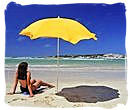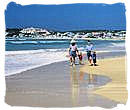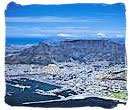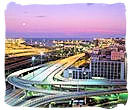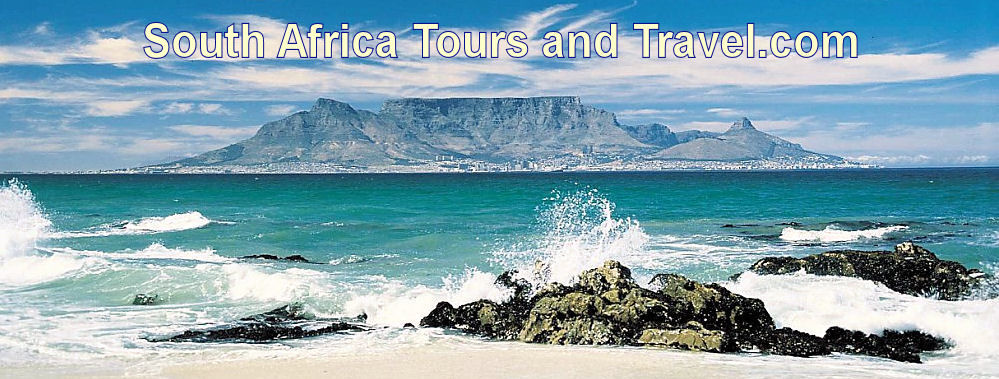 |
|||||||||
All you want to know about South Africa 's major cities |
|||||||||
|
Johannesburg
|
|
Cape Town
|
|
Durban
|
|
Pretoria
|
|
Bloemfontein
|
|
Kimberley
|
|
Port Elizabeth
|
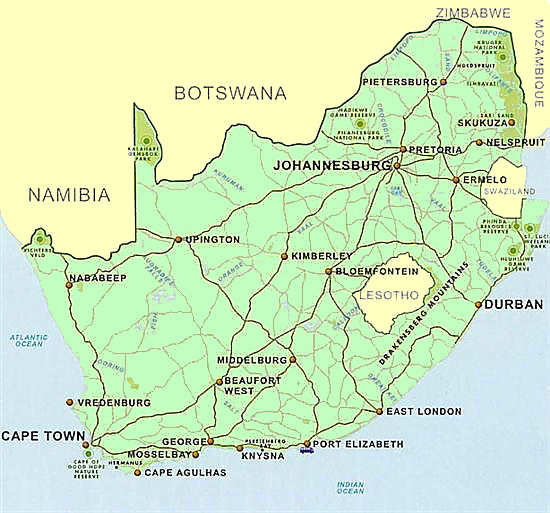
- Click anywhere on the map to clear the "Directions" window
- The button in the left-hand top corner allows you to select a larger version of the map.
- The button in the left-hand bottom corner allows you to change from street map to satellite view and vice versa.
- The plus/minus button in the right-hand bottom corner allows you to zoom in and out. You can zoom in to a detailed street map of any city or area that you select.
- Alternatively, put the mouse cursor on any location on the map that you want to explore and click repeatedly with the left hand mouse button without moving the mouse.
- Moving the mouse cursor on the map with the left hand mouse button clicked in, will allow you to move the map up and down and left and right.
- Click on the refresh button of your browser to return to the original map.
- Click anywhere on the map to clear the "view larger map" window
- The button in the left-hand top corner allows you to select a larger version of the map.
- The button in the left-hand bottom corner allows you to change from street map to satellite view and vice versa.
- The plus/minus button in the right-hand bottom corner allows you to zoom in and out. You can zoom in to a detailed street map of any city or area that you select.
- Alternatively, put the mouse cursor on any location on the map that you want to explore and click repeatedly with the left hand mouse button without moving the mouse.
- Moving the mouse cursor on the map with the left hand mouse button clicked in, will allow you to move the map up and down and left and right.
- Click on the refresh button of your browser to return to the original map.
The Mother city. "See Cape Town before you die..." That was the vote from viewers of the popular BBC travel programme “Holiday”. Choosing the 50 best overall tourist destinations, they gave our "Mother City", as it is affectionately called by us South Africans, the number 5 spot, after Sydney, New York, Venice and Paris.
It is more than five centuries ago, that the first Europeans set eyes on the natural beauty of the shape of Table Mountain and the coastline of the Cape Peninsula from the decks of their sailing ships. They were Bartholomew Diaz and his crew of seafarers. Quite aptly, they named it the Cape of good Hope.
Map of Cape Town
View Larger Map
Map of Cape Town
View Larger Map
Later it became also known as the Cape of Storms. Sometime later in 1652, the Dutch East India Company sent Jan van Riebeeck and a company of settlers to set up a halfway refreshment station on its trade routes to the Far East. Cape Town was founded. South Africa cities.
The impressive and majestic Table Mountain towers proudly above the City, flanked by the legendary Devil's Peak and the historical Signal Hill. Beautiful white sandy beaches along a peaceful coastline, frame Cape Town and the surrounding Peninsula. It all makes the Cape peninsula one of the most beautiful and striking sights in the world.
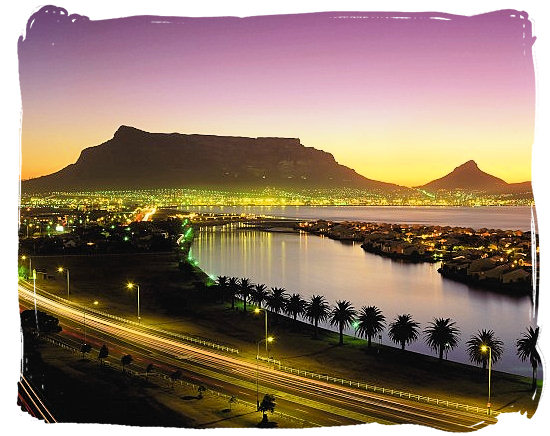
Alternatively there are the three centuries old Castle of good Hope, the panoramic boat tours around the Peninsula, an exciting array of eating and drinking places, world-class hotels, exuberant nightspots, glittering shopping malls as well as open air art and craft markets, to name but a few.
And do not forget great outdoor activities such as water sports(including diving, surfing and sailing), deep sea fishing, wine tasting, mountain biking, hiking, kite flying, parasailing, bird-and whale watching.
Last but not least, what is more romantic on a wind-still full moon summer's night then to walk up lion's Head before dark, watch the sun set on one hand and the full moon rise on the other and then to walk down in the silvery light. Come and visit Cape Town, of all the South Africa cities the place to see before you die.
Egoli, "at the gold" or "the place of gold" as the Zulu people so aptly call Johannesburg in their language. Johannesburg, capital of the province called Gauteng, which also means "place of gold", but then in the language of the Northern Sotho and the Tswana people.
Johannesburg the place of gold, capital of the province of gold in, as you can guess, the country of gold, South Africa. Exaggerating?...well, maybe just a little.
Map of Johannesburg
View Larger Map
Map of Johannesburg
View Larger Map
When you have your first encounter with Johannesburg, driving into the city on the smooth tarmac of modern multi-lane freeways between modern skyscrapers and you see a modern and vibrant metropolis packed with vitality and a throbbing African rhythm where everyone is on the move, just realize, that you are looking at the economic and financial heart of our country. Of all the South Africa cities this city is literally built on gold.
What you must also realize is the fact that only a little more than a hundred years ago, Johannesburg was nothing more than an unknown and forlorn ridge with rocky outcrops in the middle of nowhere.
Witwatersrand it was called, meaning "White waters ridge". In 1886 it all started happening. The world's richest deposits of gold were discovered and Man’s obsession with the shiny mineral did the rest. Prospectors, fortune seekers, speculators and adventurers from the ends of the earth flocked to the area.
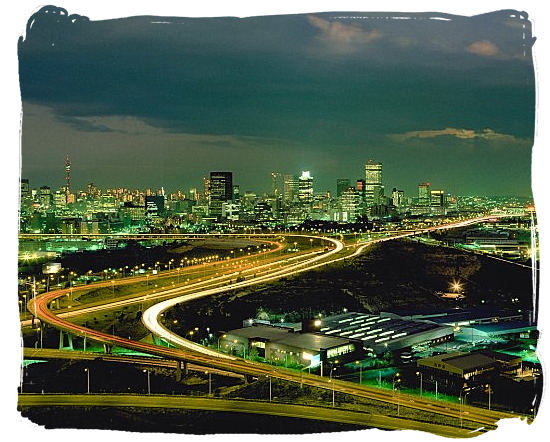
A modern fast paced cosmopolitan metropolis, bustling with energy and activity, home to 5 million people in an area no more than 60 km in diameter. A mind staggering explosion of growth and development,…the awesome power of gold.
Come and see for yourself the place of gold in the province of gold in the country of gold. An exaggeration?...you decide. Experience the exciting contrast of high rise glass and chrome corporate headquarter buildings of Sandton CBD and the third world tin shacks of the sprawling, vibrant Soweto township, a revelation to the uninitiated.
Spend a day at the amazing goldmine theme park Gold Reef City. Go shopping in the up market Sandton City or at the Randburg waterfront. These are only but a few of the many sightseeing and pleasure activities to choose from.
eThekwini, "place of the lagoon". That is how the city of Durban is called by the Zulu people. Just imagine. Golden beaches with exotic names like Golden mile beachfront, Hibiscus coast, Strelitzia coast, sugar coast, and Dolphin coast. A tropical somewhat humid climate with a curry flavoured Asiatic atmosphere, quite different from the other South Africa cities.
The kingdom of the proud warrior nation of the Zulus and the ancient and mysterious Valley of one thousand hills. An exciting and at the same time mystique mix of African and Asian cultures. And in the middle of it all, Durban, Africa's bewitching seaside playground in the sun. Yes, that should give you an idea about what this great city is all about. South Africa cities.
Map of Durban
View Larger Map
Map of Durban
View Larger Map
The natural harbour of Durban was discovered by passing Portuguese seafarers. This happened to be on Christmas day 1497, hence the reason why they named it "Rio de Natal" (the River of Christmas). It was only in 1823 that a trader by the name of Henry Fynn and his companions were the first Europeans to arrive and settle in the area. Until that time, the only inhabitants were the indigenous Zulus.
The small white settlement grew into a town and twelve years later it was named after the acting Governor of the Cape colony, Sir Benjamin D'Urban.The Zulus, having lived there for centuries, did not favour the European settlement, feeling threatened by the incursion into their territory. With the arrival of the Voortrekkers, mistrust and unease grew, resulting in a series of bloody battles.
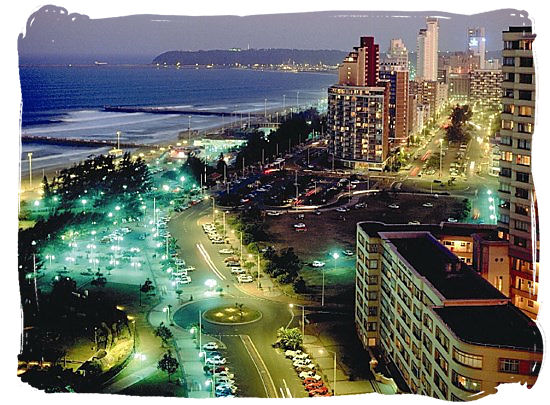
The mixture of Zulu, Briton, Voortrekker, Indian and descendents of other cultures resulted in Durban's extraordinary Afro-Asian feel and atmosphere. Today Durban is a major gateway into Africa and is also the largest and busiest port on the continent, with a population of 3 million people. It is the economic powerhouse of the zulu Kingdom, extending a warm welcome to many compelling tourist treasures.
It is also the entranceway to two of South Africa's World Heritage Sites, the majestic and magnificent Ukhahlamba Drakensberg Park and the iSimangaliso Wetlands Park, as well as huge game reserves in the Zululand bushveld, history-laden battlefields, the Valley of a Thousand Hills, and a coastal playground that seems to stretch on endlessly in both directions.
"Jacaranda City", that is how the city of Pretoria with a population of close to two million peopleis known by us South Africans. Because when its 70,000 jacaranda trees get into blossom in the spring during the months of October and November, the City is completely covered in a glorious cloud of beautiful purple blossoms. Absolutely a sight to be seen.
As capital of South Africa and the seat of Government, Pretoria has a stately character, pervaded by a strong sense of history and tranquility. While providing all the modern comforts of life, it has also sustained a unique and truly rustic ambience. The pace is markedly slower and quite relaxed compared to some of the other South Africa cities.
Map of Pretoria
View Larger Map
Map of Pretoria
View Larger Map
The fertile valleys of Gauteng have been inhabited from the earliest times. More than three centuries ago the Sotho tribes who lived there were joined by "Nguni" speaking settlers from the north, known as the Ndebele (derived from the Sotho nickname "ma Tebele", meaning "refugee"). They were the first people to recognize the Apies river valley as a suitable place to settle.
They named the river after Tshwane, a son of one of their chiefs named Mushi. The word "Tshwane" means "little monkeys". In the Afrikaans language it means "Apies". The next people to settle in this beautiful valley were Europeans in the form of the19th century "Voortrekkers". They were mainly farmers who had sought to get away from British rule and domination in the Cape Colony.
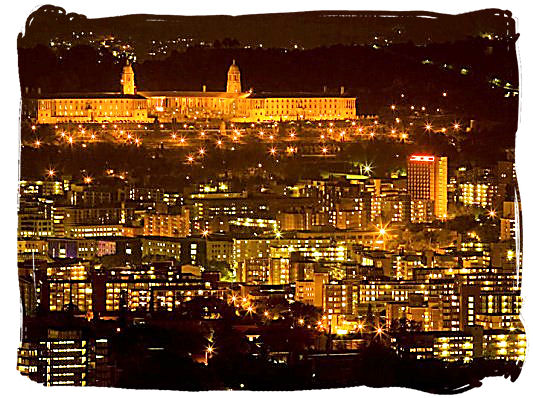
The City Council of Pretoria has recently decided to give the city a new name. The city that was named after voortrekker hero Andries Pretorius, will soon officially be known as the City of Tshwane. South Africa cities.
Pretoria is situated in a strategic location, within easy reach (about 50 km) of Johannesburg International Airport. It is a gateway to many favourite tourist destinations, from the famous Kruger National Park, Sun City, Pilanesberg Game Reserve and other popular game lodges to the beaches of Kwa-Zulu natal.
The cultural minded visitor has a choice of 35 museums with spectacular displays of all aspects of the country's heritage. In Pretoria you can walk in the footsteps of heroes, follow the tracks of wild animals, enjoy cocktails amidst incredible scenery or dance and gamble the night away. Whatever your liking, Pretoria has it all.
Bloemfontein, meaning "Fountain of flowers", is what Rudolph Marthinus Brits called the flowery piece of land around a strong natural well that he had bartered from the local tribal chief in the year1840. He had left Swellendam in the Cape colony in search of farming land and better grazing for his cattle.
His cousin joined him and soon they had developed the land into a flourishing farm. A popular stopover with the migrating Voortrekkers and passing travelers, it soon grew into a bustling little town, which was officially founded in 1846. Up to today the well is still flowing in downtown Bloemfontein.
Map of Bloemfontein
View Larger Map
Map of Bloemfontein
View Larger Map
Bloemfontein, the Capital of the Free State province and also the Judicial Capital of the country, is the sixth largest of the South Africa cities, with a population of close to a million people. The area in which it lies in the province is called the Motheo region. Motheo is the Sesotho word for "foundation" or "strong base of a building", a reference to the fact that the region is situated in the centre of the free State province.
It is a region of golden fields of wheat and maize, and endless grasslands where sheep and cattle graze. Being situated in the geographic heartland of South Africa, Bloemfontein is an important stopover at the crossroads of important road, air and railway links, running from north to south and east to west between the South Africa cities across the country.
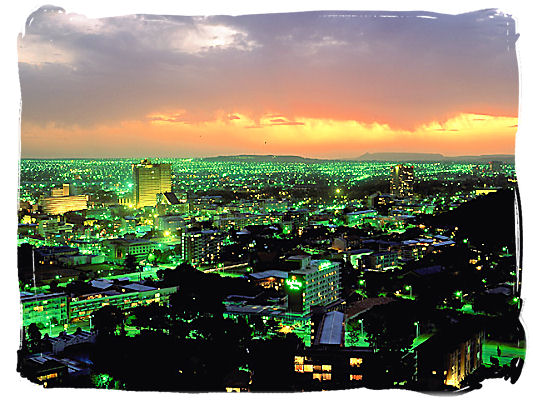
Long ago the local Sesotho people gave Bloemfontein the name "Mangaung", meaning "the place where cheetahs dwell", a reminder that this area was teeming with wildlife long before man arrived here.
When driving through this beautiful and charming city, one notices the unobtrusive and almost natural inclusion of an impressive architectural and historical heritage into the bustling life of a modern and developing city. A unique blend of past, present and future.
Today Bloemfontein offers the visitor outstanding accommodation establishments and attractions ranging from art galleries, theatres, top class restaurants, night clubs and pubs to historical buildings, monuments, stately museums, including a game reserve uniquely situated in the heart of the city.
Kimberley,…from a diamond diggers shanty town called “New Rush” to Kimberley, the Diamond Capital of the world. What a story! The year is 1866. The place, the farm "De Kalk" near a little town called Hopetown on the banks of the Orange river. Event, Young Erasmus Jacobs picks up a pretty white pebble and puts it in his pocket.
"Eureka", the pebble was called, after somebody discovered that it was a diamond of 21,25 carats. The year is 1871. another place, a small hill called "Colesberg kopje" on the farm "Vooruizicht" of the de Beer brothers. A labourer called Damon picks up three strange looking stones and shows them to his boss. Later, one of those stones would become the famous 83,50 carat "Star of Africa".
Map of Kimberley
View Larger Map
Map of Kimberley
View Larger Map
It sparked off the biggest diamond rush the world has ever seen, a mad scramble for fame and fortune. Within a matter of months some 50,000 diggers from all corners of the world were swarming all over the "Colesberg kopje". When the hill was gone, they simply kept on digging, creating the biggest and deepest manmade hole in the world.
It had a perimeter of about 300 by 200 meters and a depth of close to 1100 meters, known worldwide as the "Big Hole". Around the hole a shanty town sprang up, aptly named "New Rush". In 1873 The name of the mushrooming town was changed to Kimberley, after the Earl of Kimberley, who was British Secretary of State for the colonies at that time.
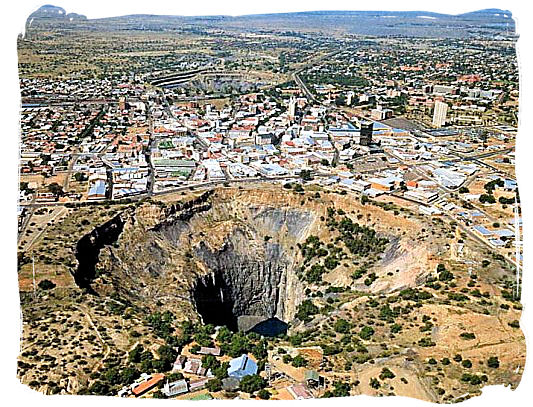
To this day "De Beers" has remained the largest supplier of diamonds in the world, while Kimberley has become a prosperous and thriving metropolis, worthy of the title "Diamond Capital of the World". Without the frenzied pace of some of the larger South Africa cities, it offers a wealth of tourist attractions.
Attractions and activities ranging from tracing the origins of humankind at archaeological sites, plunging a kilometre deep into mother Earth visiting a working "De Beers" diamond mine, viewing an ancient collection of more them 3000 San rock paintings and exploring everyday life in a township, to fly-fishing, game viewing and dune climbing, to name but a few.
Port Elizabeth, "The Friendly City" as it is known by many visitors. Friendly because of its great hospitality and its fantastic weather. It is rated as having the fourth best weather conditions in the world. Locals affectionately just call their city "The Bay" (English), or "Ibhayi" (Xhosa people), or "Die Baai" (Afrikaners).
Port Elizabeth is South Africa’s fifth city and third largest port situated at the Algoa Bay coastline. Together with the municipalities of Uitenhage and Despatch it forms the "Nelson Mandela Metropolis", with a population of close to 1,5 million people. With its 80 km coastline of beautiful beaches, the fantastic weather and its enormous range of attractions, it is probably South Africa's best-kept tourism secret.
Map of Port Elizabeth
View Larger Map
Map of Port Elizabeth
View Larger Map
The first European to venture into the Bay was the Portuguese explorer Bartholomeu Diaz who, after having rounded the Cape of Storms (Cape Town) in March 1488, stepped ashore in the bay which he named "Bahia de la Roca".
Later it was renamed "Bahia de Lagoa" (from which the name Algoa Bay was derived, meaning "Bay of the lagoon"), by a later explorer Manuel de Perestrelo in 1576. Until the 18th century it did not become more than just a refreshment station on the sea routes to Mozambique and the Far East.
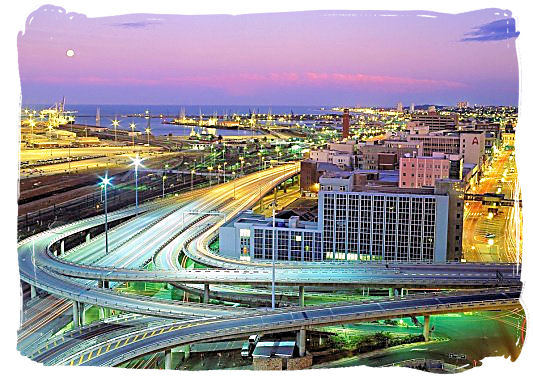
He named the settlement after his late wife Elizabeth on 6 June 1820. That put Port Elizabeth on the map and it quickly established itself between the other South Africa cities as the main port of the Eastern Cape province, developing rapidly.
Today Port Elizabeth is the gateway to the famous Garden Route region, including game reserves, the Addo Elephant Park, the historical town of Grahamstown, Jeffrey’s Bay, "the place of the perfect Wave", and many more. It offers the perfect combination of warm water, a calm sea, and fair breezes.
It is one of the best sailing venues in the world and a mecca for all beach and water sport enthusiasts. At the end of each enjoyable day, a relaxing evening including sundowner cruises, top notch restaurants, sparkling night clubs, late night music spots and fine art theatre performances.







